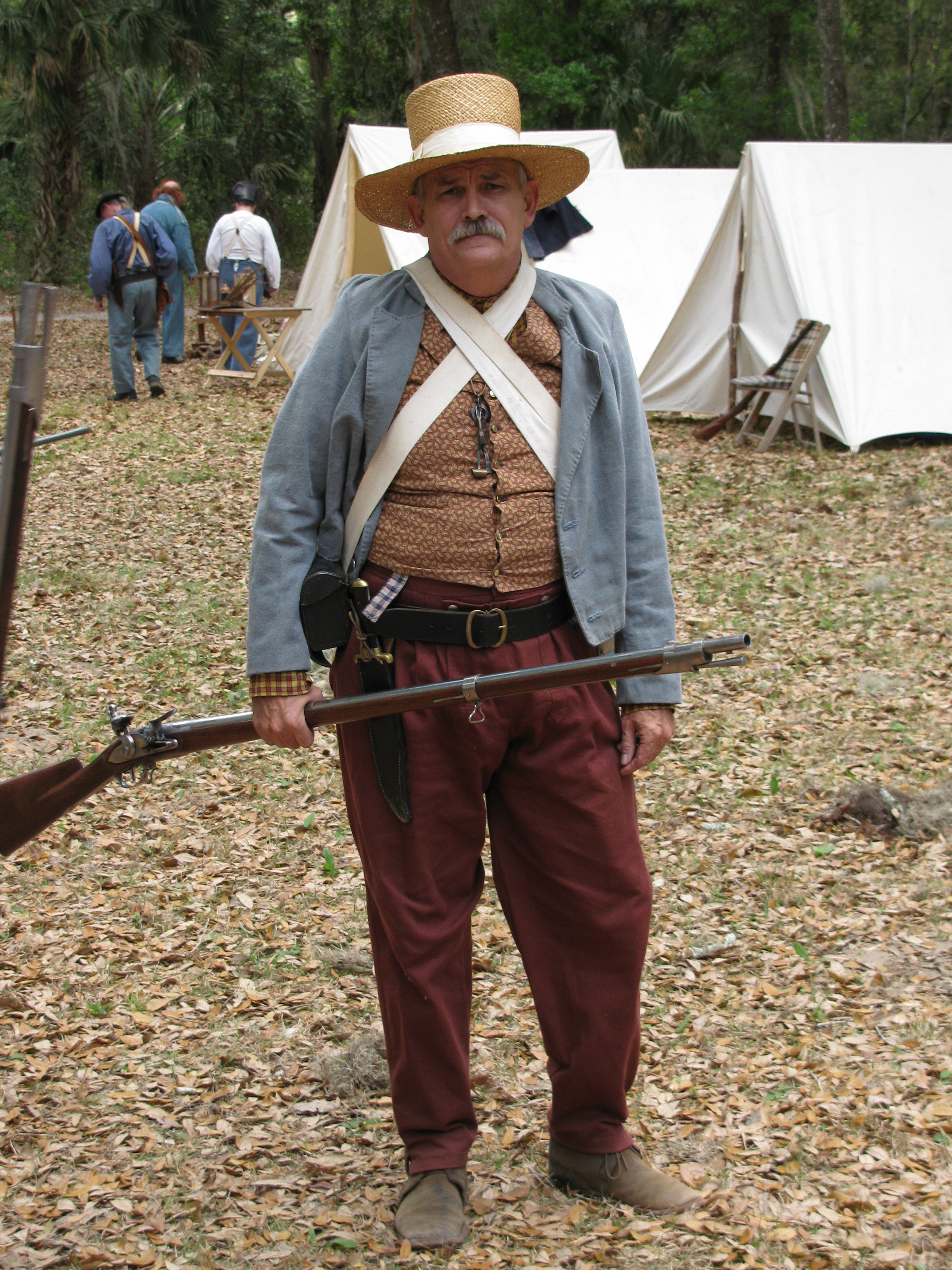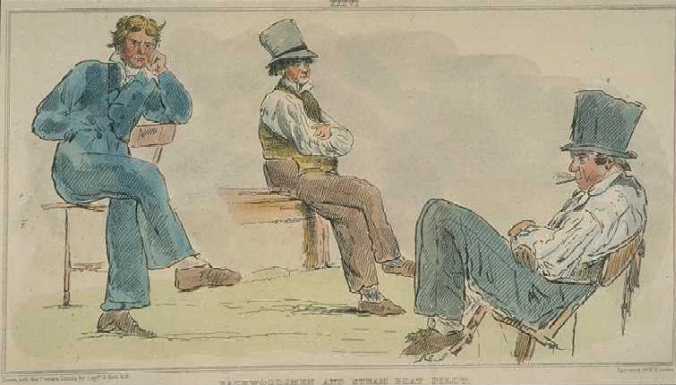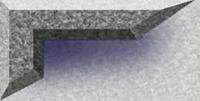|
|
Notes regarding the dress of militia and volunteer soldiers
of the Second Seminole War, 1835-1842.
| photo
by Amiee Marshall |
|
|
Private
Greg Chappell of the FFG as a typical militiaman/volunteer of the 2nd Seminole War era.
|
|
 |
|
The Dress of the "Florida Frontier Guard' s" Soldiers is the common dress of American of American men during
the period 1835-1840.
This includes the following basic garments:
A man's Common hat, or woven straw hat. (7-inch crown, 3 to 6-inch brim)
Fur Forage Cap. (rabbit is best, as it is readily available.)
Cloth Forage cap. (from pattern in the "Workwoman's Guide" 1838).
A man's Round Jacket. (citizen's coat, frock coat, hunting frock, or military coat or jacket is acceptable).
A mans' vest.
Man's pantaloons (tight) or trousers (loose). broad-fall and small-fall preferred.
Man's leather shoes (period correct).
Black cotton cravat or colored Neckerchief.
White or other color period square-cut shirt.
Period ankle length cotton or flannel drawers (optional).
"Why no uniforms?"
In the present day, the idea of American soldiers without uniforms seems
odd. Regardless, that is exactly the condition of state volunteer troops in United States service in the period
1815-1861. Instead, the soldiers were each paid clothing money by the US government for providing their own clothes.
Only the soldiers of the small regular army were legally allowed government issue clothing.
The volunteer and militia troops who served in the "Florida War" generally did not wear
uniforms of any kind. Regardless, some, particularly at the company level, had some sort of "uniform" clothing, but most were
dressed as described by Lt. W.W. Smith of the South Carolina Volunteers, in "hunter's dress, homespun, or common
clothes" into Florida service. These included "strong" garments of fustian (sturdy cotton goods, like corduroy or velveteen,
often dyed a "leaden or olive" color), and occasionally common citizen's coats "which had seen enough service [at home] to
recomend them for a campaign." A description of the South Carolina officers of 1836 noted many wore leggings, and some even
"caoutchouc" or india rubber treated coats "of dingy hue and buckram starchness" which were popular in the period.
Men commonly wore hats in society, but in the 1830s caps were popular for gentlemen while travelling.
W.W. Smith says among the troops in Florida in the winter of 1835-1836 "nearly all wore the mocknuter, or foraging cap,"
made from the fur of muskrats, rabbit, or fox. Several contemporary images of such caps may be found in the 1830s paintings
of William Sydney Mount, and others.
The Florida Territorial militia also appears to have foregone the use of uniforms for active
service. Achille Murat describes Florida militia wearing homespun cotton clothing, and woven palmetto hats (they were popular
in hot weather in the period...). Surgeon's Steward John Bemrose of the 2nd Artillery noted that the Florida Mounted
Volunteers of 1835-1836 wore plain "planter's dress" with the swords of the officers alone distinguishing them from their
men. "Planters' dress" in the period was the wear of a linen (or cotton) round jacket in lieu of a coat, and a broad brimmed
hat. M. Myer Cohen noted in 1836 that the militia of St. Augustine paraded with cockades affixed to their hats. In 1839
a battalion of Florida troops was described as armed with rifles, wearing broad brimmed hats and "short jackets."
Some Contemporary Descriptions of Militia/Volunteer troops.
There are several descrptions of the dress of common militia and US volunteers
during the 1830s. The account of Brisbane's South Carolina Regiment of volunteeers is the best available regarding the dress
of volunteer troops in the 2nd Seminole War. Below are some concerning the dress of various groups of "citizen soldiers" in
active service during the 2nd Seminole War period:
Florida Mounted Volunteers, Call's Brigade, 1835-1836:
General Call arrived at Fort Drane [FL] with his forces. The West Florida horsemen were a splendid lot
of fellows. They were evidently taken from the planters and farmers. Each was armed with a rifle, their officers carrying
swords to distinguish them, being all dressed alike in plain planter's dress...[John Bemrose, p. 38]
Capt. Elmore's Columbia & Richland (South Carolina) Rifle Corps, 1836:
Wore..."the usual dress of riflemen, viz. drab frock shirts trimmed with green fringe..."
[from W.W. Smith, 1836, p. 114.]
South Carolina Volunteers (Brisbane's Regiment), February, 1836:
Of the various companies of this regiment, only two wore anything approaching a "uniform."
The Irish Volunteers ( a uniformed volunteer militia company from Charleston) wore uniforms of "similar stuff" as Elmore's
Riflemen, but of "darker hue... in close bodied short coats, lined with their favorite green, a broad stripe of which ran
along the outer seam of their trowsers." Except for that company, the volunteers were "scarcely distinguished by any difference
in their attire; all wore plain dresses and such as were best adapted to the woods and swamps."
Among these "plain" dressed companies; the "Edgefield Blues" had a "uniform dress"
of "plain blue cloth coattees, ornamented with a few brass buttons on the skirts and sleeves, and trowsers that corresponded.
the rest were clothed in woodsmen's suits, in native homespun, or in their usual home garb; almost all wore mocknutters, or
foraging caps of the fur of the muskrat, rabbit, or fox, with tassels, and pink and white cockades affixed to them." [W.W.
Smith, 1836, p. 114.]
Georgia Mounted Volunteers, Cherokee, GA, August, 1836:
...A company of Georgia Mounted Volunteers rode through this place on their way to the Cherokee Council. All
had their coats off with their muskets and cartouche boxes strung across their shoulders. Some of the men had straw hats,
some of them with white felt hats, others had old black hats on with the rim torn off, and all of them were as unshaven and
as dirty as they could well be. The officers were only distinguished by having Cherokee fringed hunting shirts on. Many of
the men were stout young fellows, and they rode on, talking, and cursing and swearing, without any kind of discipline....
Militia Muster, Clarke County, GA, June, 1839
...While the commanding officer, under whose review they were to pass, was dressed in a field officer's full
uniform of blue and silver, and mounted on a fine charger richly caparisoned; the battalion that marched before him was as
grotesque as the most ingenious caricaturist could make it. About a dozen of the whole number had muskets, some with bayonets,
some without; and these were carried in as many different ways as there were pieces. The rest of the troop, about one hundred
in number, carried sticks, umbrellas, waggoner's whips, and large planks or rails. Their dresses too, were as varied as their
arms; some wore cloth coats, others white cotton jackets, and many were in their shirt sleeves; while hats of all kinds, black,
white, and straw, broad-brimmed and narrow, made up the motley dress of this strange company; and in marching, the aim seemed
to be to make the line as irregular as possible, and cause every man to step out of time. In short they seemed to labor under
the influence of symetriphobia....
Militia Parade in Savannah, GA, ca. 1840:
...Scarcely any two men are dressed alike or took the same step, and, whenever I saw them approaching, some
with a shoe on one foot and a boot on the other, some with their guns wrong end up and others with them on their shoulders,
wearing their knapsacks bottom up and wrong side out, I could not held thinking one might suppose they were learning how to
catch up their guns and knapsacks and effect the most speedy escape in time of danger....
Arms & Accouterments.
The documentary evidence suggests that the overwhelming number of militia and volunteer
units of the 2nd Seminole War were armed with United States muskets or rifles, and corresponding accouterments. During the
1820s-1830s the bulk of the arms produced by the US Government were distributed to the various states based on the returns
of the strength of their militias. These arms were then either stored by the state or distributed to the militia units or
individuals. The larger part of these arms were made by the various government contractors, in "contract brown" finish on
the barrels, etc.
The militia of the Territory of Florida was in an un-organized condition when the 2nd Seminole
War broke out in 1835. Consequently, General Richard Kieth Call (later Territorial governor etc.) purchased a large number
of shotguns to equip the Florida mounted volunteers who subsequently engaged in the first campaign of the war in late 1835. The
South Carolina militia companies which travelled to St. Augustine to assist in the defense of that place in early 1836 did
so equipped with state arms and equipments. The majority of the "militia" units of the war served in Florida as US volunteer
troops, and were consequently equipped with weapons and accouterments from the various US arsenals.
General Winfield Scott drew arms etc. from several of these arsenals in early 1836 to equip
the US volunteers, including those at Augusta, GA and Mount Vernon, AL, etc. General Gaines drew arms from the arsenal at
Baton Rouge, LA to equip Col. Persifor Smith's Louisiana Regiment during the same period. The larger portion of these stockpiled
US arms were likely War of 1812 and earlier vintage. This accounts for the widespread find of old pattern US Army 1808 brass
oval bayonet scabbard belt plates in Florida.The arsenals drawn on for arms for the Florida War were subsequently restocked
with new made arms and accouterments while the old patterns were exhausted and worn out in Florida by "volunteers and [US
service] Indians."
When the volunteers were mustered out of service, they left their arms and accouterments
in Florida, where they were stockpiled in ordnance depots at Tampa Bay and Garey's Ferry ready for issue to new incoming volunteer
units.
|

|
John
Mitchell in typical 1830s laborer's dress, perfect for a campaign in Florida.
|

|
This
1830s painting shows the typical undress of working men.
|
| Library
of Congress. |
|
|
South
Carolina Mounted Men of Col. Goodwyn's Regiment at the Withlacoochee River, 1836.
|
|
 |
|
 |
|
 |
| |
|

|
| 1828
view of southern backwoodsmen, and a steam boat pilot, by Basil Hall. | | |
|

